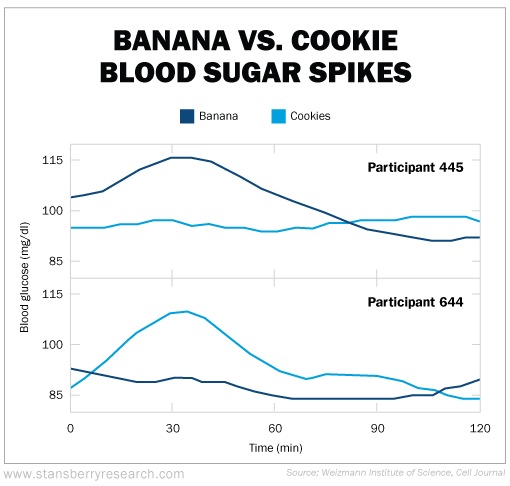Banana or cookie...
Which do you think would spike your blood sugar more?
It might seem like your blood sugar should spike more with a cookie than a banana, but that's not always the case.
This past November, science journal Cell published a study that the mainstream media has largely ignored...
The study tracked 800 people... eating about 50,000 meals... and for the first time ever, researchers found proof that folks respond to food differently.
Your individual body's makeup can determine how well you break down foods.
Some participants had high spikes in their blood sugar with a cookie, but not a banana. Other participants saw the opposite – they had spikes from the banana, but not the cookie. Take a look at these two participants...
This drastic difference shows that people respond to food differently.
And there are lots of factors involved... Your weight, exercise habits, sleep, blood pressure, even the small bacteria that live in your colon all contribute to how you process the food you eat.
I know what you're thinking – why bother with the diabetic dietary guidelines I wrote about? It turns out, those guidelines still help a great deal.
Regularly testing your blood sugar and keeping a food journal will help you figure out if there's a specific food that triggers your blood spikes.
But while diet alone won't help you completely manage your diabetes, here is one thing that will help your blood sugar no matter what you eat...
Just add exercise.
And as it turns out, the best exercise for controlling your blood sugar might seem too simple, too easy. But that's why it works so well...
I'm talking about walking.
Walking is great exercise. It's easier on your joints but still provides many of the same benefits as jogging or running.
The reason it works so well with diabetes has to do with insulin.
For someone without diabetes, the pancreas releases more insulin when he eats something so it can break down the increased food. His body responds well to the insulin and breaks down the sugars correctly.
Folks with type 2 diabetes either have trouble making insulin or their body doesn't respond to it as well anymore. That means after eating, the sugar from your food isn't broken down. That leads to high blood sugar – something called postprandial hyperglycemia.
Hyperglycemia means your body isn't breaking down sugars that you can use for energy. Left untreated, it can damage your eyes, kidneys, nerves, and lead to cardiovascular problems.
But researchers found that going for a walk after a meal directly lowers your blood sugar.
[optin_form id="286"]
One study published by the Journal of the American Medical Directors Association measured blood sugar levels in people given the same food. Half the participants walked before the meal and half walked after the meal.
They tested the blood sugar of participants every 30 minutes and saw that those who walked after dinner had lower levels. Just 20 minutes of self-paced walking about 15 to 20 minutes after the meal helped these participants lower their blood sugar.
Walking after a meal helps prevent developing diabetes, too.
Another massive study called the Nurses' Health Study and the Health Professionals Follow-Up Study found that brisk walking for 30 minutes a week cuts your risk of developing type 2 diabetes by 30%.
Exercise directly lowers your blood sugar by bypassing insulin... When you work your muscles, they contract and allow your muscle cells to absorb glucose without the help of insulin. Once they have the glucose, muscle cells break it down to use it for energy.
Remember though, if you exercise for too long or after skipping a meal, you may be at risk for hypoglycemia. Symptoms include shakiness, loss of coordination, and irritability. Making sure you eat properly and testing your blood if you have any symptoms are important to staying safe.
Do what I do and go for a walk after your meal. To get the most benefit, follow the 20-20 rule – wait for 20 minutes after eating and then walk for 20 minutes. You'll be surprised by how energized you feel.
[optin_form id="286"]
What We're Reading...
- Understanding blood sugar and exercise.
- Did you miss it? Steve Sjuggerud shares a personal missive about why he built his $1 million system for his mom and dad... It tracks all sorts of investments in real time... like health care, biotech companies, banks, and even gold and gold-mining stocks... to help you determine whether an opportunity is a "buy" or a "sell."
- Something different: The fascinating history of "Mack the Knife." Whose version of the song is your favorite? Let us know.

